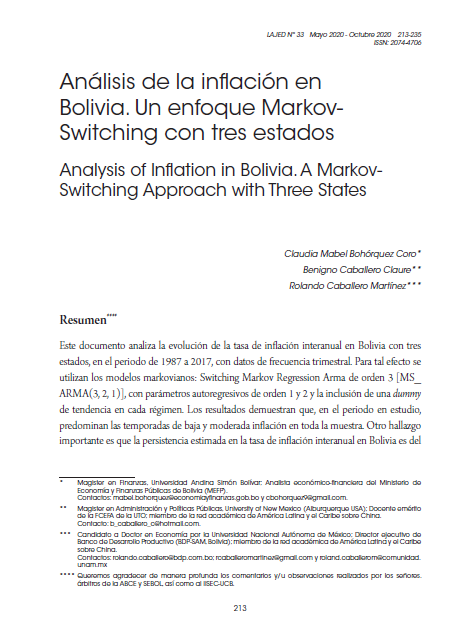Analysis of Inflation in Bolivia. A Markov- Switching Approach with Three States
DOI:
https://doi.org/10.35319/lajed.202033421Keywords:
Forecast and Simulation, Inflation Regimes, Time SeriesAbstract
This document analyzes the evolution of the inflation rate in Bolivia with three states, in the period 1987 to 2017, with quarterly frequency data. Markov Models are used for this purpose: a Switching Markov Regression of order 3 [MS_ARMA (3, 2, 1)], with autoregressive parameters of order 1 and 2 and the inclusion of a trend dummy in each regime. The results show that in the period under study, the spells of low and moderate inflation predominate throughout the sample. Another important finding is that the estimated persistence of interannual inflation rate in Bolivia is of order 0.1174, which implies a low persistence in inflation. This means that the shocks in it dissipate quickly, thus confirming the price stability that has been generated since the mid-1990s.
Downloads
References
Banco Central de Bolivia (BCB). (2007). Memoriadel Banco Central de Bolivia. Recuperado de https://www.bcb.gob.bo/?q=content/memoria-2007.
Diebold, F.X; Lee, J.H. y Weinbach, G.C. (1993). Regime-Switching with time varying transition probabilities. En C. Hargreaves (ed.), Nonstationary Time Series and Cointegration. Oxford University Press.
Diebold, F.X. y Kilian, L. (1999). Unite Root Test are Useful for Selecting Forecasting Models. NBER Working Paper Nº 6928.
Escobar, F. y Mendieta, P. (2003). Inflación y depreciación en una economía dolarizada: el caso de Bolivia. Revista de Análisis del Banco Central de Bolivia, 7(1), 7-50.
Hamilton, J. (1989). A New Approach to the Economic Analysis of Nonstationary Time Series and the Business Cycle. Econometrica, 57(2), 357-384.
---------- (1994). Times Series Analysis. Princenton University Press.
Lanne, M.; Lütkepohl, H. y Saikkonen, P. (2002). Comparison of unit root tests for time series with level shifts. Journal of Time Series Analysis, 23(6), 667-685.
Lee, J.H. (1991). Nonstationary Markov Switching Models of Exchange Rates: The Pound- Dollar Exchange Rate. PhD Dissertation, University of Pennsylvania.
Mendieta, P. y Rodríguez, H. (2008). Una curva de Phillips neokeynesiana empírica para el caso de Bolivia. Presentado en el Primer Encuentro de Economistas de Bolivia La Paz, 14 y 15 de agosto de 2008.
Morales, J. A. (1989). La transición de la estabilidad al crecimiento sostenido en Bolivia. Documento de Trabajo IISEC Nº 04/89. Universidad Católica Boliviana “San Pablo”.
Morales, J. A. y Sachs, J. (1990). Bolivia´s Economic Crisis. En J. Sachs (ed.), Developing Country Debt and Economic Performance. Chicago y Londres Press.
Orellana, W; Lora, O; Mendoza, R. y Boyán, R. (2000). La política monetaria en Bolivia y sus mecanismos de transmisión. Revista de Análisis del Banco Central de Bolivia, 3(1), 81- 123.
Orellana, W. y Requena, J. (1999). Determinantes de la inflación en Bolivia. Revista de Análisis del Banco Central de Bolivia, 2(2), 7-39.
Palmero, M. y Rocabado, P. (2013). Inercia inflacionaria en Bolivia: un análisis no estructural. Revista de Análisis de Banco Central de Bolivia, 17(1), 17-43.
Simon, J. (1996). A Markov-Switching Model of Inflation in Australia. Research Discussion Paper 9611, Economic Group, Reserve Bank of Australia.
Valdivia, V. (2008). ¿Es importante la fijación de precios para entender la dinámica de la inflación en Bolivia? Working Paper Series 02/2008, Instituto de Estudios Avanzados del Desarrollo.






